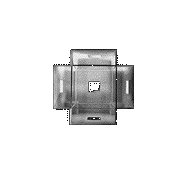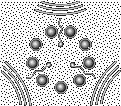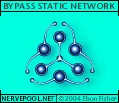
______________
Ebon Fisher's AlulA Dimension
______________
by Jennifer Dalton,
From The Performing Arts Journal (PAJ),
Johns Hopkins University Press, January 1998
At first it's hard to get a handle on exactly what it is that Ebon Fisher creates. An artist and organizer based in Williamsburg, Brooklyn, Fisher has spent much of the last fifteen years breeding freefloating artistic entities that he characterizes as neither installations, nor concept art, nor happenings, but as "media organisms," artificial life forms cultivated in the plasma of popular culture÷
As an undergraduate art major at
Carnegie-Mellon University, he decided to abandon traditional art ("we
had learned nothing about life, and too much about Alexander Calder"),
deciding that the school's science and technology program were where the
action was. As he put it, "The science students were so intense and brilliant
and engaged -- they seemed to be on the pulse of the soul of the world,
and I thought, 'Isn't art supposed to reflect the soul of the world? Why
are these scientists so much more poetic and full of rapture?"
Fisher negogiating with police at media ritual
in Boston, 1988.
The disrupted performance was "Evolution of the
Grid."

Bionic Code based on such encounters
After college, Fisher moved to Boston
where he attended graduate school at MIT's then brand-new Media Lab. In
Boston he began organizing "media rituals" -- events which incorporated
theatre, performance, art, music and a healthy dose of partying spirit.
In 1989, after one such ritual got him kicked out of his loft apartment
by his landlord, Fisher took the opportunity to relocate to Williamsburg,
Brooklyn. In the building energy of that budding artistic community (proximate
but comfortably independent from what he described as the cultural and
financial "mommy and daddy of Manhattan"), Fisher found fertile ground
for his ideas on art, technology and community. He continued to work on
enormous collaborative events in the early 1990s at venues such as Minor
Injury Gallery and the Mustard Factory building. Organism, for instance,
a one-night event in 1993, was a 12-hour extravaganza featuring the work
of 120 artists in every conceivable medium -- and then some -- and attracting
more than 2000 participants and party-goers. Fisher, more interested in
an organic, interactive, web-like model of artistic production than in
what he regards as the art historic myth of individual creativity, describes
the method of Organsim as "a web jam -- for every creative person to create
a system, a whole web throughout the site÷" Meanwhile his drawings of neurons
were evolving and mutating, and they began to reflect the observations
of behavior he gleaned from these rituals, becoming graphic abstractions
of prescriptive ethical models for human behaviour -- or as art historian
Jonathan Fineberg has written, "templates for a new social (dis)order÷"
Media Compression at Minor Injury Gallery, Williamsburg,
Brooklyn, 1990.
One of six media rituals conducted at Minor Injury
in the early 90s.

Bionic Code for a Media Compression
Fisher seeks to make explicit the proposition that the most important aspect of art is in people's minds. This idea is hardly new -- conceptual artists such as Joseph Kosuth have been working with it for decades -- but Fisher is not as comfortable as the conceptual artists were (and are) with the restricted space and audience of the gallery. Fisher wants his ideas to infiltrate, pollute and alter popular culture at large. As he and other young artists increasingly believe, "Fine arts is not culture, the culture is Walt Disney, it's Viacom, it's MTV. If you want to be a sensitive, alert artist you have to work in and around ant between the pop culture÷"
Fisher also began creating an environment
for positive interaction between humans, his bionic codes, and anything
else willing to jump on in. These models and prototypes for habitats began
with a flat diagram of a single modular room, and have grown to encompass
maps of whole networks of cubical rooms attached to one another via slender
channels which Fisher describes as analogous to phone lines in their information-sharing
potential. Each channel is also punctuated by a small "chill room" for
relaxation between all this exhausting interaction. The entire network
resembles a model of a space station; but unlike a space station, it is
not important that the "real thing" ever be built. As the represented habitat
has become more sophisticated, so has Fisher's method of representing it.
The AlulA Dimension now exists in computer-based imaging systems such as
VRML 3D, a virtual-reality program which enables users of the World Wide
Web to move through three-dimensional architectural environments such as
AlulA's successive rooms. Fisher has also built a single modular white
cube (featuring entrances to passageways which fictionally lead to other
rooms) in his apartment and is using it as a video set for filmed interactions.
As he explains this "virtual morality," he wants to "build a metaphor for
communications. I want to develop rituals and portray them in a pop fashion,
showing conflict resolution and etiquette" : a prescription for better
living.
The AlulA Dimension on the Web in
VRML 3D, which allows the user to explore the architecture of AlulA.
Web programming by Larry Rosenthal
and Alex Shamson. Architecture by Ebon Fisher.
But the physical manifestations of Alulian space are merely the means by which Fisher hopes to get his messages absorbed into memory. He believes that through viewers' accumulated visual impressions of his friendly little codes, people will be encouraged to follow the codes' imperatives and the world will be a better place. It's this earnest idealism that truly sets Fisher apart from most young visual artists, many of whom are characterized by a cynicism which is near-crippling. It's hard to create something when you don't believe in anything; there are surprising numbers of people out there trying, but Ebon Fisher is not one of them. For instance, Fisher's aphorisms directly call to mind Jenny Holzer's "truisms" -- obviously both Fisher and Holzer fervently believe that the world would be improved if everyone else would just come around to their way of thinking. But Fisher's simple, humble entreaties carry none of the condescension or irony of Holzer's bitter observations. Fisher was born and raised a Quaker, and imperatives such as "equalize wih other beings" and "link with distressed humans" fit in infinitely better next to "love thy neighbor" than they do among truisms such as "the future is stupid" or "money creates taste."
Rather than smugly tearing down, Fisher's messages are solemnly building up. The homegrown philosophy he calls "Wigglism" buoyantly circumvents deconstruction: "Unlike art, which tends towards ruptures and dissolution, nurturing lifeforms requires an active engagement with structure. Not the numbing structures we often associated with the machine age, but rather, living structures, infinitely flexible structures, wiggling structures." Such arguments are so unique and charming÷ his endearing, sophisticated sincerity is terribly refreshing in the context of all the annoying, unsophisticated irony of much contemporary art.
Fisher is neither seduced by the
art historic myth of the individual ("the world is infinite, 100 or 200
years of ego worship is really a kind of hiccup") nor is he looking to
find a place for himself among contemporary young artists. Though his bionic
codes have been shown in galleries and are included in respected publications,
he's more interested in merchandising after the modle of Calvin Klein than
after the model of Jeff Koons. Rather than making clever art historical
references, Fisher prefers the realm of daily experience and street life,
to explore what "being" means rather than what "art" means. As he explains
his priorities, "Science is a daily experience, the media is a daily experience,
the neighborhood is a daily expereince÷.It's kind of hilarious that the
goddamn fashion industry took the phrase "Just Be," like the cologne CK
Be, and just walloped a whole generation upside the head with the possibility.
But bless them for doing it! They just went dodging all around the psyche
of youth with a hugely successful marketing campaign. Why can't artists
do that, but with a little more subtlety?
